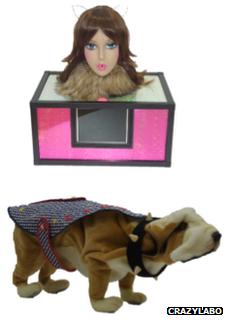Body odour robots detect smelly feet and stinky breath
- Published

Two robots that warn users if they suffer from bad body odour have been unveiled in Japan.
One resembles a woman's head and ranks the operator's breath, declaring an "emergency" if it falls into the worst category.
The other looks like a dog and growls when confronted with stinky feet.
The machines take advantage of commercially available sensors, highlighting how far the tech has evolved.
They were developed by the Fukuoka-based company CrazyLabo and the Kitakyushu National College of Technology.
However, artificial olfaction sensors - or electronic noses - have been commercially available since the early 1990s when UK-based researchers brought one of the first products to market.
Chemical fingerprint
Details of the latest machines were revealed by the Asahi Shimbun newspaper.
It reported that when a subject breathes into the mouth of the humanoid robot, named Kaori, its responses ranged from "it smells like citrus" to "there's an emergency taking place that's beyond the limit of my patience."
The dog robot, called Shuntaro, nods its head while analysing the smell of a user's feet. If the odour is not too strong it nestles up to the subject and Beethoven's Fifth Symphony plays out of its speakers.
If the feet smell stronger, it makes a growling sound. If they reek it appears to collapse and pass out.
The robots rely on gas sensors capable of creating a chemical fingerprint that can be matched to specific odours. The data is processed by embedded computers that in turn control the machines' responses.
They mark the first products to be announced by CrazyLabo, which says it now plans to make money from renting them out to events.
The company's president, Kennosuke Tsutsumi, says he was inspired to create the machines by complaints from his family about his own body odour.
Alternative to humans
Biomedical Sensors Laboratory at the University of Warwick says it was the first to develop a "commercial" electronic nose in a project it worked on with Neotronics, a gas detection specialist.
The work, funded by the brewer Bass, was designed to find a way to detect contaminants in the brewing process as an alternative to using human sniffers.
"How far have we gone downhill?" joked Dr James Covington, head of the lab, when he heard of the latest development.
"When we started, the sensors weren't sensitive enough or selective enough, but things have moved on," he added.
"Sensing materials are getting better, substrates are getting better, processing power is going up.
"The two main driving forces for research are military - people want to be able to detect chemical warfare agents - and environmental monitoring."
Cancer diagnosis
He added that although the medical industry was not a major source of research funding, several companies were working to take advantage of advances.
A Dutch company, Enose, is developing Aeonose, a smell-based diagnostic kit designed to help screen for tuberculosis, asthma and throat cancer.
The US-based Alpha Szsenszor is working on equipment to study human breath to detect lung cancers and other diseases.
And the University of Bristol has been working on a project called Odour Reader, which analyses vapour collected from patients' stool samples to help diagnose causes of diarrhoea.
Even so, current technologies are still less sophisticated than the human nose.
The human olfactory system contains about 100 million receptors that make use of approximately 350 million different types of protein. By contrast, electronic noses typically use 32 or fewer chemical-based sensors housed in a basic chamber.
Government approval
Still, Dr Covington said the technology was mature enough to mean smell-based sensors were likely to come to smartphones by the end of the decade. He noted the Tricorder Xprize - sponsored by smart device chip-maker Qualcomm - was helping to spur on development of the doctor-on-a-phone concept.
"If you can breathe on the machine it will be able to tell you if you've got bad breath, but it might also help you monitor something like Crohn's disease," he said.
"One of the issues is that for certain applications, if you want to put the gas sensors on a phone, you would have to get approvals from government agencies.
"But I've already seen plug-in prototypes for a number of applications."
- Published8 March 2012
- Published20 April 2011
- Published2 May 2007